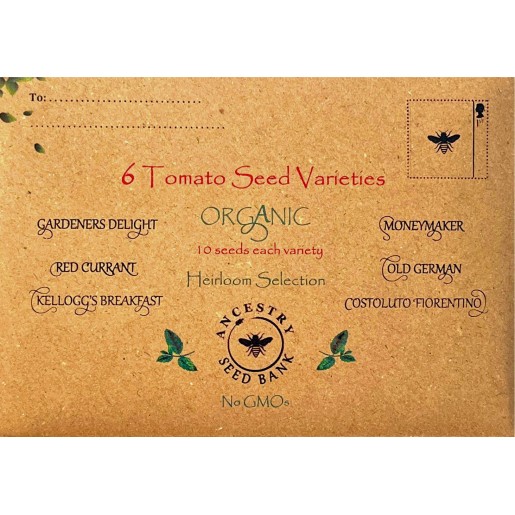6 Tomato Seed Varieties
GARDENERS DELIGHT
RED CURRANT
KELLOGG’S BREAKFAST
MONEYMAKER
OLD GERMAN
COSTOLUTO FIORENTINO

You have the option to mail it directly to your friends and family. Simply affix a stamp and turn it into a thoughtful gift.
Cultivate a diverse and vibrant tomato garden with his hand picked collation of non-GMO heirloom seeds, carefully chosen for the exceptional flavour, unique characteristic and rich history. Join us in preserving the legacy of these time-honoured varieties and indulge in the incomparable taste of homegrown organic tomato. Your garden is about to become a living testament of the beauty of biodiversity and the deliciousness of nature’s bounty.
PLANTING & GROWING
Soaking needs to be done at least a few hours before planting, and preferably overnight. To prevent damping off when starting seeds indoors, it’s essential that you disinfect all of your pots, plastic grow trays, seed cells, and seedling tray covers before you reuse them.
Prefers well-drained, Organic fertile soil, high in organic matter. Clays and loams produce the highest yields. But lighter soils that drain and warm quickly can produce earlier harvests -- particularly if they are on a slight slope to the south or southeast. Can tolerate slightly acid soils, as low as pH 5.5. But produces best when pH is 6.0 to 6.8. Consistent moisture needed to prevent blossom end rot, but does not tolerate waterlogged soils.
Sow seed in flats, and nurture them until they are at least 8 inches (20.5 cm.) tall and exterior soil temperatures are at least 60 F. (16 C.). Give tomatoes full, direct sunlight 8 hours or more per day.
Allow spacing of at least 5 feet (1.5 m.) for good air circulation and install sturdy cages or other support structures.
Indeterminate tomato plants continue to grow and produce tomatoes, limited only by the length of the season until frost kills the vine. These plants produce stems, leaves, and fruit as long as they are alive. Harvest may last for several months.
Tomato growers seldom allow tomato plants to actually vine. Indeterminate tomato plants will require substantial staking or caging to support what can become a large 180 to 300cm (6 to 10 ft) heavy plant. They require stakes to keep the plant from sprawling on the ground.
As the plant grows, you should prune it regularly. As side branches form on the main stem, pinch out "suckers" or new growth when they are young and only 1/2 inch long that form in the crotch of the stronger branches. Do this weekly throughout the growing season to ensure that the plant develops no more than one or two main stems. This will make it easier for the plant to grow on the trellis, and it will slow upward growth and promote better branching. As the stem grows, wrap it around the twine in the same direction each time.
When there are companions with the tomato plants, some fragrant friends such as basil, garlic, or onions can mask the smell of tomato and make them more difficult for pests to locate.
Tomato is a heavy feeder and should be fertilized with an organic blend rich in phosphorus and potassium and containing moderate nitrogen. To reduce root disease risk, don't plant on soils that have recently grown tomatoes, potatoes, peppers, or eggplant for at least two years. or near any members of the Brassicaceae family.
Since cross pollination between most tomato varieties is unlikely, isolation is not a concern. Like most heirloom tomatoes only needs natural pollinators like honeybees, bumblebees, and wind.

